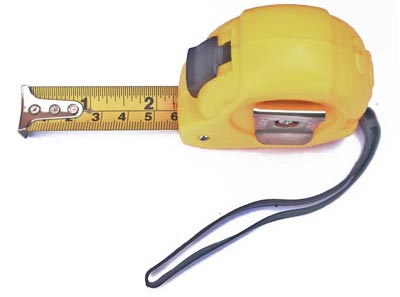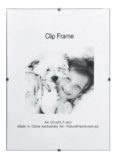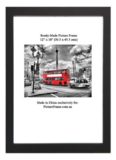In order to buy the correct picture frame for that print or photo you that have, you will need to know what its size it is first. A nd to know what size it is, you'll have to measure it even if these are in "inches" frame sizes instead of the more familiar, centimetres. Thing is, if you're from Europe, schooled and grown up with centimetres and decimetres, you would always have measured everything in decimetres, centimetres or millimetres. So when you go to buy and look for photo frames or picture frames, and you find a lot of them still labelled in Imperial sizes such as 8"x10" or 11"x14", chances are that you'll be a little confused. After all Australia is supposed to be a metric country, right, so what's going on? ..
nd to know what size it is, you'll have to measure it even if these are in "inches" frame sizes instead of the more familiar, centimetres. Thing is, if you're from Europe, schooled and grown up with centimetres and decimetres, you would always have measured everything in decimetres, centimetres or millimetres. So when you go to buy and look for photo frames or picture frames, and you find a lot of them still labelled in Imperial sizes such as 8"x10" or 11"x14", chances are that you'll be a little confused. After all Australia is supposed to be a metric country, right, so what's going on? ..
From modern Australia's beginnings in 1788, up to 1971, the mother country's English, or Imperial system of measurements, which included feet and inches had been the only and official one. Thus, for picture framers in picture framing, making picture frames and photo frames, inches were the most commonly used unit of measure.
Picture frames were known, made, bought and sold in sizes such as 8"x10", 11"x14, 20"x30", etc. However, traditions and common usage die hard, and many older customers and country residents still ask for photo frames in common, handy size such as 8"x10" and 11"x14" . The double quotes (") accompanying the numbers denote that the measurements are in inches. Australia superseded the Imperial system in the early 1970's for a number or reasons.
Perhaps chief amongst these is that world progress, commercial facilitations and modern science more commonly flourish in SI units. Australia wanted to foster a scientifically literate environment and nation and sought to ensure that scientists and the common people spoke, wrote and understood the same scientific language. It also desired to be more internationally competitive and did not wish to be remain at at disadvantage by lagging behind in international commerce, trade and transactions.
A large part of the problem was also the fallacy or assumption many held that Imperial and American Customary units were the same, but this has never been the case. Take for instance the litre. Everyone, no matter where they come from, agree how large and what its volume is. Then take a British and an American pint. They're not the same, they're different! Britain and America have different volumes for wet and dry pint measures. Concomitantly, an ounce could refer to a fluid ounce, to a troy ounce or to an avoirdupois ounce.
Convert from Imperial to Metric With a Tape
This is but one example of dissimilar similarities. The universal advantage of the metric system is that it is easy, logical, international, unambiguous. That said, if you're from Europe and don't know Imperial or U.S. sizes, there a couple of simple enough ways by which you can fairly easily convert Imperial measurements to metric ones.
One is to buy yourself ( a cheap enough accessory which you can be bought at most stores ) a tape measure with both an Imperial and a metric scale. These are quite cheap and easily found at 2-dollar shops. We actually sell such measuring tapes, a our 3- metres, dual scale, with Inches at the top, and Centimetres, is shown below:
 Simply run the tape along, say an 8"x10" photo frame, and you'll see its exact size in both Imperial and metric graduations, or measurements.. Another way is to Google for the conversion of "inches" frame sizes that you may, of which there are about a dozen of good sites offering quick and easy conversions. Yet another one is to multiply any whole Inches ( without fractions ) by 25.4, thuss 8"x10" Inches = 20.32 x 25.4 cm.
Simply run the tape along, say an 8"x10" photo frame, and you'll see its exact size in both Imperial and metric graduations, or measurements.. Another way is to Google for the conversion of "inches" frame sizes that you may, of which there are about a dozen of good sites offering quick and easy conversions. Yet another one is to multiply any whole Inches ( without fractions ) by 25.4, thuss 8"x10" Inches = 20.32 x 25.4 cm.
Convert from Imperial to Metric With Our Online Tool
Perhaps a last method for getting free picture frames sizes conversions is to use our Covert Sizes & Measurements calculator in our customer-friendly web site PictureFrame.com.au which features a free sizes and measurements conversion tool on its home page left sidebar.
A last issue worth mentioning is the Imperial to Metric conversion "rounding off " practice. For instance, the popular size of 16"x20" converts exactly to 40.64 x 50.8 cm . However a lot of the frames are made overseas with with descriptions which round off numbers.
Thus, 40.64 x 50.8 cm is often rounded off and printed with the facepapers displaying simply 40 x 50 cm. The facepaper is the piece of paper that comes with a frame showing or describing to buyers and Customers , its size, dimensions, description and other pertinent details.
This rounding off practice may seem harmless enough but it can cause problems to discerning Customers. This is because of the variance between the two disparate sizes, the accurate size of, say 40.64 x 50.8 cm and the rounded off and inaccurate, or smaller size of 40 x 50 cm.
Adapting Printed Art to Off-The-Shelf-Frames
Customers buy prints from overseas, or often do their own printing which may or may not exactly fit the frame. A Customer with a print slightly larger than the frame may be reluctant to cut or time his or her artwork for fear of damaging it. Cibachromes and super-glossy prints, for instance, are notoriously difficult to handle and cut or trim off without scuffing or damaging the emulsions.
By the same token, a smaller, rounded off paper, print, or artwork size may be just that bit smaller than the frame and show one or more of the four paper edges under the glass, perhaps because the moulding rebate may happen to be smaller than normal, or undersize. In these case, the artwork may need to be re-printed which is not always feasible, or possible.
Occasionally Customers grumble or remark that, since many Imperial size frames, particularly poster size frames, can be difficult to source and buy here in Australia, that the U.S. ought to get its act together and start changing over to metric so as to catch-up with the rest of the world.
We think that this is a rather forlorn hope, particularly in view of the Trump factor which mostly predicates that it is the world that should follow America's lead, rather than the other way around.
Thank you for reading this inches frame sizes post "I'm from Europe and confused about the "Inches" frame sizes, what are these?".
What To Do and Not To Do With Frames Conversions
| List of Do's | List of Don'ts | ||
| ✓ | Do carry a small pocket tape measure with you, It might well save you some back-and-forth trips to the photo store. | ❌ | Don't expect Department Store Staff to be of great help when buying photo frames. Most employees are young and inexperienced in picture framing or picture frames sizes and measurements. |
| ✓ | Do make a mental note of the main Imperial to Metric conversion factor. And that is: 1 inch is 25.4 mm or 2.54 cm. It'll help some. | ❌ | Don't bank on the larger Department Stores stocking Imperial sizes frames. Generally these carry only A-Series sizes or European sizes. |
| ✓ | Do remember that an 8" x 12" photo frame ( 20.3 x 30.5 cm ) is roughly equal in size to an A4 ( 21 x 29.7 cm). | ❌ | Don't expect any store Staff to fit-up or put your photos or art inside the frames for you, either for free or by way of paid service. Off-the-shelf frame are sold cheaply because it's the Customers that are supposed to do this work. |
| ✓ | Do take your photo with you when shopping. You'll be able to place it against the frame and see it is fits or not. | ❌ | Don't think that a store will refund you if you've taken home some wrong size frames and opened them up. All frames are factory-packaged by shrink-wrapping. Once opened, these cannot be re-wrapped and re-sold to other Customers. |










Yours is a very informative website and I enjoy reading your posts. This one on English sizes and their history in Australia is also interesting to read. Thank you.
I fell like i have gone back to school reading this article but it was an interesting lesson nonetheless! I never understood why picture frames were often measured or quote in inches. I got a quote from a picture frame for my artwork which was 11 x 14 inches and he asked me whether i knew the measurement in millimeters. I was lost when he said that as i had no tape measure. We were on the phone so i found a conversion site on the internet like what’s mentioned in this article. It really helped as the framer knew exactly what size i was talking about. I guess i started to speak some sense! However if i run into this problem again, i’ll just use pictureframe.com.au and the size converter that’s on this site! Thankful for this article.